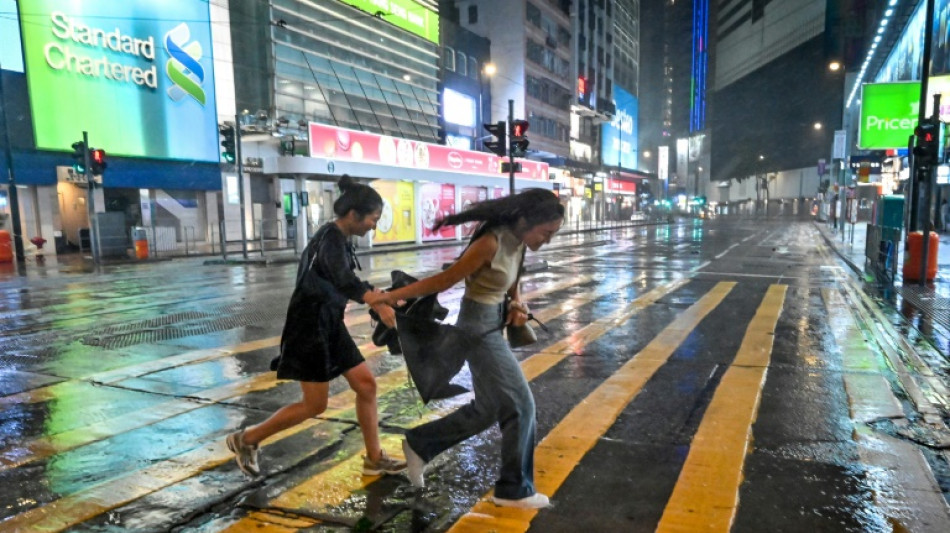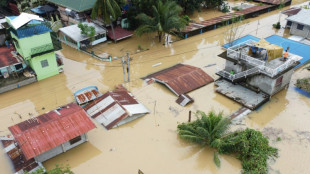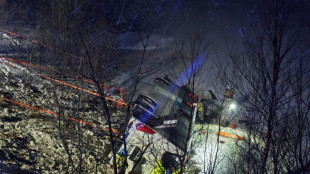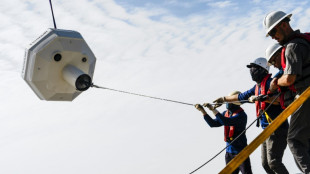
-
 Netflix with Beyonce make splash despite NFL ratings fall
Netflix with Beyonce make splash despite NFL ratings fall
-
Bird flu mutated inside US patient, raising concern

-
 Slovakia says ready to host Russia-Ukraine peace talks
Slovakia says ready to host Russia-Ukraine peace talks
-
Maresca challenges Chelsea to react to Fulham blow

-
 Tech slump slays Santa rally, weak yen lifts Japan stocks higher
Tech slump slays Santa rally, weak yen lifts Japan stocks higher
-
Test records for Zimbabwe and Williams as Afghanistan toil

-
 LawConnect wins punishing Sydney-Hobart yacht race
LawConnect wins punishing Sydney-Hobart yacht race
-
Barca's Yamal vows to 'come back better' after ankle injury

-
 Olmo closer to Barcelona exit after registration request rejected
Olmo closer to Barcelona exit after registration request rejected
-
Watching the sun rise over a new Damascus

-
 Malaysia man flogged in mosque for crime of gender mixing
Malaysia man flogged in mosque for crime of gender mixing
-
Montenegro to extradite crypto entrepreneur Do Kwon to US

-
 Brazil views labor violations at BYD site as human 'trafficking'
Brazil views labor violations at BYD site as human 'trafficking'
-
No extra pressure for Slot as Premier League leaders Liverpool pull clear

-
 Tourists return to post-Olympic Paris for holiday magic
Tourists return to post-Olympic Paris for holiday magic
-
'Football harder than Prime Minister' comment was joke, says Postecoglou

-
 Driver who killed 35 in China car ramming sentenced to death
Driver who killed 35 in China car ramming sentenced to death
-
Bosch gives South Africa 90-run lead against Pakistan

-
 French skier Sarrazin 'conscious' after training crash
French skier Sarrazin 'conscious' after training crash
-
NATO to boost military presence in Baltic after cables 'sabotage'

-
 Howe hopes Newcastle have 'moved on' in last two seasons
Howe hopes Newcastle have 'moved on' in last two seasons
-
German president dissolves parliament, sets Feb 23 election date

-
 Slot says 'too early' for Liverpool title talk
Slot says 'too early' for Liverpool title talk
-
Mayotte faces environment, biodiversity crisis after cyclone

-
 Amorm says 'survival' aim for Man Utd after Wolves loss
Amorm says 'survival' aim for Man Utd after Wolves loss
-
Desertions spark panic, and pardons, in Ukraine's army

-
 China sanctions US firms over Taiwan military support
China sanctions US firms over Taiwan military support
-
World number six Rybakina makes winning start at United Cup

-
 Israeli strikes hit Yemen airport as WHO chief prepares to leave
Israeli strikes hit Yemen airport as WHO chief prepares to leave
-
Swiatek not expecting WADA appeal over doping scandal

-
 'Dangerous new era': climate change spurs disaster in 2024
'Dangerous new era': climate change spurs disaster in 2024
-
Fritz motivated for Slam success after low-key off-season

-
 Move over Mercedes: Chinese cars grab Mexican market share
Move over Mercedes: Chinese cars grab Mexican market share
-
Zverev aiming to challenge Sinner for top ranking

-
 N. Korean soldier captured in Russia-Ukraine war: Seoul
N. Korean soldier captured in Russia-Ukraine war: Seoul
-
Inspired Tsitsipas looking to 'refresh, regroup' in Australia

-
 Seahawks edge Bears to boost NFL playoff hopes
Seahawks edge Bears to boost NFL playoff hopes
-
Thunder NBA win streak at nine as Shai ties career high with 45

-
 India announces state funeral for ex-PM Manmohan Singh
India announces state funeral for ex-PM Manmohan Singh
-
Japan govt approves record budget for ageing population, defence

-
 Japanese shares gain on weaker yen after Christmas break
Japanese shares gain on weaker yen after Christmas break
-
South Korea's acting president faces impeachment vote

-
 Fleeing Myanmar, Rohingya refugees recall horror of war
Fleeing Myanmar, Rohingya refugees recall horror of war
-
Smith century puts Australia in control of 4th Test against India

-
 Israeli strikes hit Yemen as Netanyahu fires warning
Israeli strikes hit Yemen as Netanyahu fires warning
-
Peru ex-official denies running Congress prostitution ring

-
 Australia's Smith reaches 34th Test century
Australia's Smith reaches 34th Test century
-
NHL Red Wings fire Lalonde and name McLellan as head coach

-
 The Bilingual Book Company Launches New, Innovative Bilingual Audiobook App
The Bilingual Book Company Launches New, Innovative Bilingual Audiobook App
-
Injured Halep withdraws from Australian Open

| CMSC | -0.55% | 23.53 | $ | |
| RIO | -0.62% | 58.885 | $ | |
| JRI | -0.91% | 12.09 | $ | |
| BCC | -1.92% | 120.61 | $ | |
| SCS | 0.63% | 11.975 | $ | |
| RBGPF | -1.17% | 59.8 | $ | |
| NGG | 0.56% | 59.25 | $ | |
| RYCEF | -0.69% | 7.2 | $ | |
| BCE | -1.01% | 22.642 | $ | |
| GSK | -0.27% | 34.029 | $ | |
| BTI | -0.4% | 36.285 | $ | |
| VOD | 0.12% | 8.43 | $ | |
| CMSD | -0.46% | 23.3691 | $ | |
| RELX | -0.64% | 45.57 | $ | |
| AZN | -0.51% | 66.18 | $ | |
| BP | 0.33% | 28.945 | $ |

Super Typhoon Saola nears Hong Kong, southern China
Tens of millions of people in Hong Kong, Shenzhen and other southern Chinese megacities hunkered down indoors late Friday as Super Typhoon Saola threatened to become the strongest storm to hit the region in decades.
Over 880,000 people were evacuated across two Chinese provinces ahead of Saola making landfall, hundreds of flights were cancelled across the region, and trees were uprooted around the rain-battered streets of Hong Kong.
China's national weather office predicted Saola "may become the strongest typhoon to make landfall in the Pearl River Delta since 1949", referring to a low-lying region that includes Hong Kong, Macau and Guangdong province.
With a direct hit possible, authorities in Hong Kong raised the warning level on Friday evening to the city's highest -- "T10" -- which had only been issued 16 times since World War II before Saola.
"Do not go outside... Stay away from exposed windows and doors because glass, already under strain from wind pressure, will shatter easily if hit by a flying object," the Hong Kong Observatory warned in a bulletin released after the highest alert was issued.
Hong Kong residents struggled with flailing umbrellas as they ran under the unrelenting rainfall, while people wearing plastic bags on their heads rushed home past sandbags stacked in waterfront areas to prevent flooding.
By 11:00 pm Saola was 30 kilometres (18 miles) south-southwest of the city, the "closest to Hong Kong at present" and packing sustained wind speeds of 185 kilometres per hour.
"Members of the public should stay on high alert. You are advised to remain where you are if protected and be prepared for destructive winds of Saola," the observatory said.
It added that "the maximum water level may reach a historical record", warning that "there will be serious flooding".
The last time Hong Kong issued a T10 warning was in 2018, when Typhoon Mangkhut slammed into the city, shredding trees and unleashing floods, and leaving more than 300 people injured.
In mainland China, Mangkhut killed six people and impacted the lives of more than three million others.
Across the mainland border in neighbouring Guangdong province, authorities evacuated more than 780,000 people from high-risk areas, while eastern Fujian province saw more than 100,000 moved to safer ground.
Trains in and out of Guangdong were also suspended until 6:00 pm Saturday, while the national flood defence agency raised its emergency response for prevention to its second-highest level.
"It's going to affect our life," said Wu Wenlai, 43, who had to close his restaurant in a Shenzhen suburb.
"My eldest son was planning to fly to Chengdu today for university and his flight has been cancelled now."
- More intense typhoons -
Southern China is frequently hit in summer and autumn by typhoons that form in the warm oceans east of the Philippines and then travel west.
Climate change has increased the intensity of tropical storms, with more rain and stronger gusts leading to flash floods and coastal damage, experts say.
In Hong Kong, authorities received at least seven confirmed cases of flooding, as well as nearly 40 reports of downed trees. The city's hospital authority reported a total of seven people seeking medical treatment during Saola.
Businesses taped up their glass displays and windows, while high-rise buildings swayed under the whipping gusts.
In eastern Heng Fa Chuen -- a coastal residential area and the site of devastation during 2018's Typhoon Mangkhut -- officers in orange vests urged storm-watchers to go home, as trees leaned sideways from the heavy gusts.
In the low-lying fishing village of Lei Yue Mun, which is prone to flooding, water seeped into shops, prompting residents to set up sandbags and board up doors.
"I hope we can save the tools needed for our business, like the fridge. We elevated them so the water wouldn't damage the (electronics)," a restaurant operator surnamed Lee told a local TV station.
burs-dhc/mlm
C.Cassis--PC




